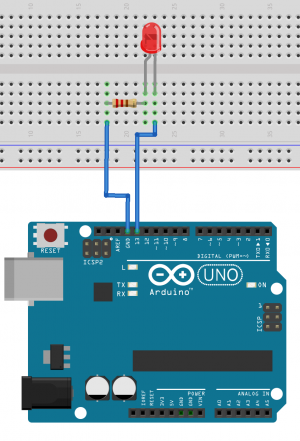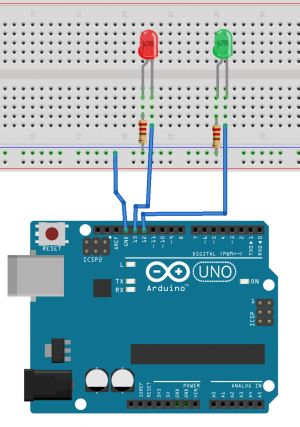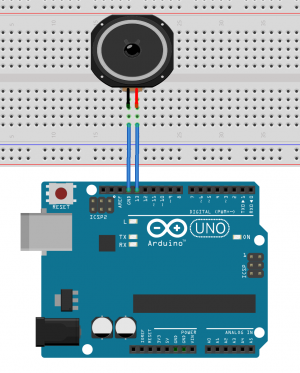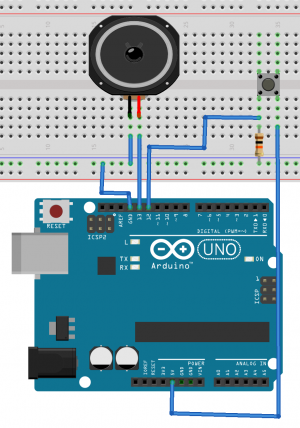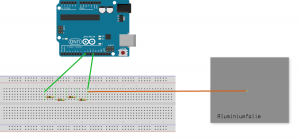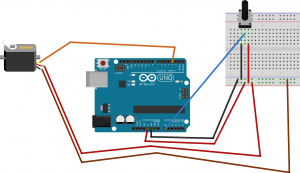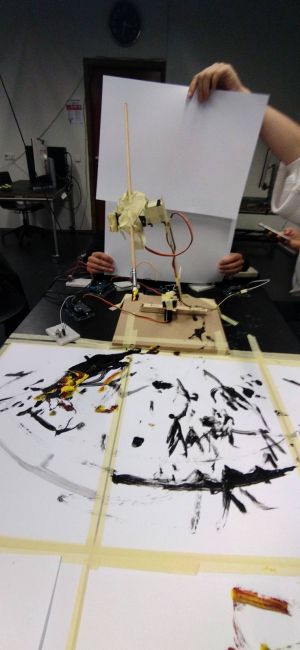Difference between revisions of "How it's made 2223"
Jump to navigation
Jump to search
| (43 intermediate revisions by 2 users not shown) | |||
| Line 10: | Line 10: | ||
=2022-09-08= | =2022-09-08= | ||
* WH.02.125 (Prototyping Space IAS) 9:00 - 16:00 | * WH.02.125 (Prototyping Space IAS) 9:00 - 16:00 | ||
| − | ==Introduction | + | ==Introduction== |
| − | + | ===1. Circuit bending=== | |
| − | + | ||
| − | + | ===2. Introduction Arduino=== | |
| − | + | ====Hello World!==== | |
| − | + | <pre> | |
| + | void setup() { | ||
| + | } | ||
| + | |||
| + | void loop() { | ||
| + | Serial.println("Hello World!"); //sends a message to the computer | ||
| + | } | ||
| + | </pre> | ||
| + | ==== Simple Led blink example ==== | ||
| + | |||
| + | [[File:Led-blink.png|thumb|center]] | ||
| + | <pre> | ||
| + | int ledPin = 13; //the int ledPin is 13 | ||
| + | |||
| + | void setup() { | ||
| + | pinMode(ledPin,OUTPUT); //ledPin is a OUTPUT | ||
| + | } | ||
| + | |||
| + | void loop() { | ||
| + | digitalWrite(ledPin,HIGH); //turns pin 13 on | ||
| + | delay(500); //stops the loop for 500 milliseconds | ||
| + | digitalWrite(ledPin,LOW); //turns pin 13 off | ||
| + | delay(500); //stops the loop for 500 milliseconds | ||
| + | } | ||
| + | </pre> | ||
| + | ==== Traffic light example ==== | ||
| + | [[File:Led-traffic-light bb.png|thumb|center]] | ||
| + | <pre> | ||
| + | int RedLedPin = 13; //the int RedLedPin is 13 | ||
| + | int GreenLedPin = 12; //the int GreenLedPin is 12 | ||
| + | |||
| + | void setup() { | ||
| + | pinMode(RedLedPin,OUTPUT); //ledPin is a OUTPUT | ||
| + | pinMode(GreenLedPin,OUTPUT); //ledPin is a OUTPUT | ||
| + | |||
| + | } | ||
| + | |||
| + | void loop() { | ||
| + | digitalWrite(GreenLedPin,HIGH); //turns green led on | ||
| + | delay(5000); //stops the loop for 5000 milliseconds | ||
| + | for(int i = 0; i < 5; i++){ //this for loop gets 5 times repeated | ||
| + | digitalWrite(GreenLedPin,LOW); //turns green led off | ||
| + | delay(500); //stops the loop for 500 milliseconds | ||
| + | digitalWrite(GreenLedPin,HIGH); //turns green led off | ||
| + | delay(500); //stops the loop for 500 milliseconds | ||
| + | } | ||
| + | digitalWrite(GreenLedPin,LOW); //turns green led off | ||
| + | digitalWrite(RedLedPin,HIGH); //turns red led on | ||
| + | delay(5000); //stops the loop for 5000 milliseconds | ||
| + | digitalWrite(RedLedPin,LOW); //turns red led on | ||
| + | } | ||
| + | </pre> | ||
| + | ==== Speaker example ==== | ||
| + | [[File:Speaker bb.png|thumb|center]] | ||
| + | <pre> | ||
| + | int speaker = 13; //int speaker is 13 | ||
| + | |||
| + | void setup() { | ||
| + | pinMode(speaker, OUTPUT); //pin 13 is an output | ||
| + | } | ||
| + | |||
| + | void loop() { | ||
| + | for(int i = 100; i< 1000;i++){ //for loop counts from 100 to 1000 | ||
| + | tone(speaker, i); //generates a tone on pin 13 with the frequency of int i | ||
| + | delay(10); //stops the code for 10 milliseconds | ||
| + | } | ||
| + | } | ||
| + | </pre> | ||
| + | ==== Speaker and button example ==== | ||
| + | [[File:Speaker&button bb.png|thumb|center]] | ||
| + | <pre> | ||
| + | //code generates on button press a random tone | ||
| + | int speaker = 13; //int speaker is 13 | ||
| + | int button = 12; //int speaker is 12 | ||
| + | |||
| + | void setup() { | ||
| + | Serial.begin(115200); //makes a serial connection to the computer | ||
| + | pinMode(speaker, OUTPUT); //pin 13 is an output | ||
| + | pinMode(button, OUTPUT); //pin 12 is an output | ||
| + | } | ||
| + | |||
| + | void loop() { | ||
| + | bool buttonState = digitalRead(button); //reads pin 12 & bool is a on or off value | ||
| + | if(buttonState == HIGH){ //if the button is HIGH(pressed) | ||
| + | int randomValue = random(100,1000); // creates an int called randomValue with a random value between 100 and 1000 | ||
| + | tone(speaker, randomValue); //creates an tone on pin 13 with the random value as frequency | ||
| + | delay(500); //stops the loop for 500 milliseconds | ||
| + | } | ||
| + | } | ||
| + | </pre> | ||
=2022-09-15= | =2022-09-15= | ||
| − | * WH.02.125 (Prototyping Space IAS) | + | * WH.02.125 (Prototyping Space IAS) 10:00 - 16:00 |
| − | == | + | ==Capacitive Sensor printing values to Serial Monitor== |
| − | + | [[File:Theremin.png|thumb|center]] | |
| + | <pre> | ||
| + | #include <CapacitiveSensor.h> | ||
| + | CapacitiveSensor sensor = CapacitiveSensor(8,11); | ||
| + | long raw; | ||
| + | void setup(){ | ||
| + | sensor.set_CS_AutocaL_Millis(0xFFFFFFFF); | ||
| + | Serial.begin(115200); | ||
| + | Serial.println("raw"); | ||
| + | } | ||
| + | void loop(){ | ||
| + | raw = sensor.capacitiveSensor(10); | ||
| + | Serial.println(raw); | ||
| + | delay(10); | ||
| + | } | ||
| + | </pre> | ||
| + | |||
| + | ==Theremin== | ||
| + | <pre> | ||
| + | #include <CapacitiveSensor.h> | ||
| + | |||
| + | CapacitiveSensor sensor = CapacitiveSensor(8,11); | ||
| + | |||
| + | int speaker = 13; //connect a speaker between pin 13 and GND | ||
| + | long raw; | ||
| + | |||
| + | |||
| + | void setup(){ | ||
| + | sensor.set_CS_AutocaL_Millis(0xFFFFFFFF); | ||
| + | Serial.begin(115200); | ||
| + | Serial.println("raw"); | ||
| + | } | ||
| + | void loop(){ | ||
| + | raw = sensor.capacitiveSensor(10); //lowest 450 & highest 750 | ||
| + | raw = min(raw, 750); //max value of raw is 750 | ||
| + | raw = max(raw, 10); //min value of raw is 10 | ||
| + | long speakerValue = map(raw,450,750,100,4000); //scales to value from 450 and 750 to 100 and 4000 | ||
| + | tone(speaker,speakerValue); //plays the frequency (raw) on port 13(speaker) | ||
| + | Serial.print(raw); | ||
| + | Serial.print(" "); | ||
| + | Serial.println(speakerValue); | ||
| + | |||
| + | } | ||
| + | </pre> | ||
| + | |||
| + | ==Capactive sensor as button== | ||
| + | <pre> | ||
| + | #include <CapacitiveSensor.h> | ||
| + | |||
| + | CapacitiveSensor sensor = CapacitiveSensor(8,11); | ||
| + | |||
| + | int speaker = 13; | ||
| + | long raw; | ||
| + | |||
| + | |||
| + | void setup(){ | ||
| + | sensor.set_CS_AutocaL_Millis(0xFFFFFFFF); | ||
| + | Serial.begin(115200); | ||
| + | Serial.println("raw"); | ||
| + | } | ||
| + | void loop(){ | ||
| + | raw = sensor.capacitiveSensor(10); //lowest 450 & highest 750 | ||
| + | if(raw > 600){ //if raw is bigger than 600 | ||
| + | Serial.println("touched"); //print "touched" | ||
| + | tone(speaker,440); //play a tone with 440 hz | ||
| + | delay(1000); //stop 1000 second | ||
| + | noTone(speaker); //stop playing the tone | ||
| + | } | ||
| + | delay(10); | ||
| + | |||
| + | } | ||
| + | </pre> | ||
| + | |||
| + | ==Servo motor movement between 0 and 90 degrees== | ||
| + | <pre> | ||
| + | //this example controls a standard servo motor and moves it between 0 and 90 degrees | ||
| + | //the servo has three different wires | ||
| + | //the red wire is plus and connected to 5v | ||
| + | //the brown wire is minus and connected to GND | ||
| + | //the orange wire is the signal wire and connected to pin 3 (remember the ~-symbol - it means PWM) | ||
| + | |||
| + | #include <Servo.h> | ||
| + | |||
| + | |||
| + | |||
| + | Servo theServo; | ||
| + | |||
| + | void setup() { | ||
| + | Serial.begin(115200); | ||
| + | theServo.attach(3); | ||
| + | } | ||
| + | |||
| + | void loop() { | ||
| + | for(int i = 0; i < 90; i++){ | ||
| + | theServo.write(i); | ||
| + | Serial.println(i); | ||
| + | delay(50); | ||
| + | } | ||
| + | for(int i = 90; i > 0; i--){ | ||
| + | theServo.write(i); | ||
| + | Serial.println(i); | ||
| + | delay(10); | ||
| + | } | ||
| + | } | ||
| + | </pre> | ||
| + | |||
| + | ==automatic trash can - servo motor connected capactive sensor== | ||
| + | <pre> | ||
| + | #include <Servo.h> | ||
| + | #include <CapacitiveSensor.h> | ||
| + | |||
| + | CapacitiveSensor sensor = CapacitiveSensor(8,11); | ||
| + | |||
| + | Servo theServo; | ||
| + | long raw; | ||
| + | |||
| + | void setup() { | ||
| + | Serial.begin(115200); | ||
| + | theServo.attach(3); | ||
| + | sensor.set_CS_AutocaL_Millis(0xFFFFFFFF); | ||
| + | Serial.begin(115200); | ||
| + | Serial.println("raw"); | ||
| + | } | ||
| + | |||
| + | void loop() { | ||
| + | raw = sensor.capacitiveSensor(10); //lowest 450 & highest 750 | ||
| + | if(raw > 600){ //if raw is bigger than 600 | ||
| + | open(); //do void open | ||
| + | delay(4000); //wait for 4 seconds | ||
| + | close(); //close void opne | ||
| + | } | ||
| + | } | ||
| + | |||
| + | void open(){ | ||
| + | //open | ||
| + | for(int i = 0; i < 90; i++){ //count from 0 to 90 | ||
| + | theServo.write(i); //move the servo from 0 to 90 | ||
| + | Serial.println(i); | ||
| + | delay(50); | ||
| + | } | ||
| + | } | ||
| + | |||
| + | void close(){ | ||
| + | //close | ||
| + | for(int i = 90; i > 0; i--){ | ||
| + | theServo.write(i); | ||
| + | Serial.println(i); | ||
| + | delay(10); | ||
| + | } | ||
| + | } | ||
| + | </pre> | ||
| + | |||
| + | ==trash can controlled by serial commands== | ||
| + | <pre> | ||
| + | //in this sketch the servo is controlled by serial commands from the computer | ||
| + | //if you send the letter "o" to the arudino it will execute "void open()" | ||
| + | //if you send the letter "c" to the arduino it will execute "void close()" | ||
| + | #include <Servo.h> //import the servo library | ||
| + | |||
| + | Servo theServo; //create a servo | ||
| + | |||
| + | void setup() { | ||
| + | Serial.begin(115200); //serial connection | ||
| + | theServo.attach(3); //theServo is at port 3 (remeber the ~(PWM)-Symbol | ||
| + | } | ||
| + | |||
| + | void loop() { | ||
| + | if(Serial.available()){ //if there is a serial command comming | ||
| + | char command = Serial.read(); //read the serial command | ||
| + | if(command == 'o'){ //is the command and 'o' | ||
| + | open(); //do void open | ||
| + | } | ||
| + | if(command == 'c'){ | ||
| + | close(); | ||
| + | } | ||
| + | } | ||
| + | } | ||
| + | |||
| + | void open(){ | ||
| + | //open | ||
| + | for(int i = 0; i < 90; i++){ //count from 0 to 90 with int i | ||
| + | theServo.write(i); //i is the servo position | ||
| + | Serial.println(i); //print the servo position to the serial monitor | ||
| + | delay(50); //wait for 50 milliseconds | ||
| + | } | ||
| + | } | ||
| + | |||
| + | void close(){ | ||
| + | //close | ||
| + | for(int i = 90; i > 0; i--){ | ||
| + | theServo.write(i); | ||
| + | Serial.println(i); | ||
| + | delay(10); | ||
| + | } | ||
| + | } | ||
| + | </pre> | ||
| + | ==Potentiometer opening the trash can== | ||
| + | [[File:Servo potentiometer.png|thumb|center]] | ||
| + | <pre> | ||
| + | //in this sketch the servo is controlled by an potentiometer | ||
| + | //a potentiometer is a variable resistor that can be changed by rotation | ||
| + | #include <Servo.h> //import the servo library | ||
| + | |||
| + | Servo theServo; //create a servo | ||
| + | |||
| + | void setup() { | ||
| + | Serial.begin(115200); //serial connection | ||
| + | theServo.attach(3); //theServo is at port 3 (remeber the ~(PWM)-Symbol | ||
| + | } | ||
| + | |||
| + | void loop() { | ||
| + | int value = analogRead(A0); //read the analog pin A0 the value is between 0 and 1023 | ||
| + | value = map(value,0,1023,0,180); //adjust value from 0 to 1023 to 0 and 180 because the servo works with degrees | ||
| + | theServo.write(value); | ||
| + | } | ||
| + | </pre> | ||
=2022-09-22= | =2022-09-22= | ||
| − | * WH.02.110 (Instruction Room IAS) | + | * WH.02.110 (Instruction Room IAS) 10:00 - 16:00 |
| − | == | + | ==presentation== |
| − | * | + | Desinger with unconventional approaches: |
| − | * | + | * Enzo Mari - Autoprogettazione? ([https://syllabus.pirate.care/library/Enzo%20Mari/Autoprogettazione_%20(221)/Autoprogettazione_%20-%20Enzo%20Mari.pdf pdf]) |
| − | * | + | * Christian Kuhtz - Einfälle statt Abfälle (ideas against trash) ([https://einfaellestattabfaelle.wordpress.com/ link to website]) |
| − | * | + | |
| + | Unconventional projects with microcontrollers: | ||
| + | * Paul Granjon - Fluffy Tamagotchi ([https://www.zprod.org/zwp/fluffy-tamagotchi/ video]) | ||
| + | * Paul Granjon - The cybernetic parrot sausage ([https://www.youtube.com/watch?v=cxKOeAJucCY video]) | ||
| + | |||
| + | |||
| + | ==painting machine== | ||
| + | [[File:Paintingmachine.jpg|thumb|center]] | ||
| + | [[File:Paintingmachinevideo.mp4|thumb|center]] | ||
| + | |||
| + | ===[https://interactionstation.wdka.hro.nl/mediawiki/images/6/61/Paintingmachinevideo.mp4 Video]=== | ||
| + | <pre> | ||
| + | //in this sketch one poti controls one servo | ||
| + | #include <Servo.h> | ||
| + | |||
| + | Servo jointOne; | ||
| + | |||
| + | void setup() { | ||
| + | Serial.begin(115200); | ||
| + | Serial.println("start"); | ||
| + | jointOne.attach(10); | ||
| + | } | ||
| + | |||
| + | void loop() { | ||
| + | int value = analogRead(A0); | ||
| + | value = map(value, 0, 1023, 0, 180); | ||
| + | jointOne.write(value); | ||
| + | delay(10); | ||
| + | } | ||
| + | </pre> | ||
=2022-09-29= | =2022-09-29= | ||
| − | * WH.02.110 (Instruction Room IAS) | + | * WH.02.110 (Instruction Room IAS) 10:00 - 16:00 |
| − | == | + | ==Motor control == |
| + | <pre> | ||
| + | //connect the dc-motor to the motorshield motor port 1 | ||
| + | //connect a external power source | ||
| + | #include <Adafruit_MotorShield.h> | ||
| + | |||
| + | Adafruit_MotorShield AFMS = Adafruit_MotorShield(); | ||
| + | Adafruit_DCMotor *myMotor = AFMS.getMotor(1); | ||
| + | |||
| + | |||
| + | void setup() { | ||
| + | Serial.begin(115200); | ||
| + | AFMS.begin(); | ||
| + | myMotor->setSpeed(200); | ||
| + | myMotor->run(RELEASE); | ||
| + | } | ||
| + | |||
| + | |||
| + | void loop() { | ||
| + | myMotor->run(FORWARD); //forward | ||
| + | myMotor->setSpeed(255); //max speed | ||
| + | delay(2000); | ||
| + | |||
| + | myMotor->run(RELEASE); //break | ||
| + | delay(2000); | ||
| + | |||
| + | myMotor->run(BACKWARD); //backward | ||
| + | myMotor->setSpeed(255); //max speed | ||
| + | delay(2000); | ||
| + | |||
| + | myMotor->run(RELEASE); //break | ||
| + | delay(2000); | ||
| + | |||
| + | } | ||
=2022-10-06= | =2022-10-06= | ||
* WH.02.110 (Instruction Room IAS) 9:00 - 16:00 | * WH.02.110 (Instruction Room IAS) 9:00 - 16:00 | ||
| − | |||
| − | |||
=2022-10-13= | =2022-10-13= | ||
| − | * | + | * WH.02.110 (Instruction Room IAS) 9:00 - 16:00 |
| − | + | == == | |
| − | == | + | [[Category:2022]] |
Latest revision as of 12:25, 20 January 2023
__ __ _ __ _ __
/ / / /___ _ __ (_) /( )_____ ____ ___ ____ _____/ /__
/ /_/ / __ \ | /| / / / / __/// ___/ / __ `__ \/ __ `/ __ / _ \
/ __ / /_/ / |/ |/ / / / /_ (__ ) / / / / / / /_/ / /_/ / __/
/_/ /_/\____/|__/|__/ /_/\__/ /____/ /_/ /_/ /_/\__,_/\__,_/\___/
2022-09-08
- WH.02.125 (Prototyping Space IAS) 9:00 - 16:00
Introduction
1. Circuit bending
2. Introduction Arduino
Hello World!
void setup() {
}
void loop() {
Serial.println("Hello World!"); //sends a message to the computer
}
Simple Led blink example
int ledPin = 13; //the int ledPin is 13
void setup() {
pinMode(ledPin,OUTPUT); //ledPin is a OUTPUT
}
void loop() {
digitalWrite(ledPin,HIGH); //turns pin 13 on
delay(500); //stops the loop for 500 milliseconds
digitalWrite(ledPin,LOW); //turns pin 13 off
delay(500); //stops the loop for 500 milliseconds
}
Traffic light example
int RedLedPin = 13; //the int RedLedPin is 13
int GreenLedPin = 12; //the int GreenLedPin is 12
void setup() {
pinMode(RedLedPin,OUTPUT); //ledPin is a OUTPUT
pinMode(GreenLedPin,OUTPUT); //ledPin is a OUTPUT
}
void loop() {
digitalWrite(GreenLedPin,HIGH); //turns green led on
delay(5000); //stops the loop for 5000 milliseconds
for(int i = 0; i < 5; i++){ //this for loop gets 5 times repeated
digitalWrite(GreenLedPin,LOW); //turns green led off
delay(500); //stops the loop for 500 milliseconds
digitalWrite(GreenLedPin,HIGH); //turns green led off
delay(500); //stops the loop for 500 milliseconds
}
digitalWrite(GreenLedPin,LOW); //turns green led off
digitalWrite(RedLedPin,HIGH); //turns red led on
delay(5000); //stops the loop for 5000 milliseconds
digitalWrite(RedLedPin,LOW); //turns red led on
}
Speaker example
int speaker = 13; //int speaker is 13
void setup() {
pinMode(speaker, OUTPUT); //pin 13 is an output
}
void loop() {
for(int i = 100; i< 1000;i++){ //for loop counts from 100 to 1000
tone(speaker, i); //generates a tone on pin 13 with the frequency of int i
delay(10); //stops the code for 10 milliseconds
}
}
Speaker and button example
//code generates on button press a random tone
int speaker = 13; //int speaker is 13
int button = 12; //int speaker is 12
void setup() {
Serial.begin(115200); //makes a serial connection to the computer
pinMode(speaker, OUTPUT); //pin 13 is an output
pinMode(button, OUTPUT); //pin 12 is an output
}
void loop() {
bool buttonState = digitalRead(button); //reads pin 12 & bool is a on or off value
if(buttonState == HIGH){ //if the button is HIGH(pressed)
int randomValue = random(100,1000); // creates an int called randomValue with a random value between 100 and 1000
tone(speaker, randomValue); //creates an tone on pin 13 with the random value as frequency
delay(500); //stops the loop for 500 milliseconds
}
}
2022-09-15
- WH.02.125 (Prototyping Space IAS) 10:00 - 16:00
Capacitive Sensor printing values to Serial Monitor
#include <CapacitiveSensor.h>
CapacitiveSensor sensor = CapacitiveSensor(8,11);
long raw;
void setup(){
sensor.set_CS_AutocaL_Millis(0xFFFFFFFF);
Serial.begin(115200);
Serial.println("raw");
}
void loop(){
raw = sensor.capacitiveSensor(10);
Serial.println(raw);
delay(10);
}
Theremin
#include <CapacitiveSensor.h>
CapacitiveSensor sensor = CapacitiveSensor(8,11);
int speaker = 13; //connect a speaker between pin 13 and GND
long raw;
void setup(){
sensor.set_CS_AutocaL_Millis(0xFFFFFFFF);
Serial.begin(115200);
Serial.println("raw");
}
void loop(){
raw = sensor.capacitiveSensor(10); //lowest 450 & highest 750
raw = min(raw, 750); //max value of raw is 750
raw = max(raw, 10); //min value of raw is 10
long speakerValue = map(raw,450,750,100,4000); //scales to value from 450 and 750 to 100 and 4000
tone(speaker,speakerValue); //plays the frequency (raw) on port 13(speaker)
Serial.print(raw);
Serial.print(" ");
Serial.println(speakerValue);
}
Capactive sensor as button
#include <CapacitiveSensor.h>
CapacitiveSensor sensor = CapacitiveSensor(8,11);
int speaker = 13;
long raw;
void setup(){
sensor.set_CS_AutocaL_Millis(0xFFFFFFFF);
Serial.begin(115200);
Serial.println("raw");
}
void loop(){
raw = sensor.capacitiveSensor(10); //lowest 450 & highest 750
if(raw > 600){ //if raw is bigger than 600
Serial.println("touched"); //print "touched"
tone(speaker,440); //play a tone with 440 hz
delay(1000); //stop 1000 second
noTone(speaker); //stop playing the tone
}
delay(10);
}
Servo motor movement between 0 and 90 degrees
//this example controls a standard servo motor and moves it between 0 and 90 degrees
//the servo has three different wires
//the red wire is plus and connected to 5v
//the brown wire is minus and connected to GND
//the orange wire is the signal wire and connected to pin 3 (remember the ~-symbol - it means PWM)
#include <Servo.h>
Servo theServo;
void setup() {
Serial.begin(115200);
theServo.attach(3);
}
void loop() {
for(int i = 0; i < 90; i++){
theServo.write(i);
Serial.println(i);
delay(50);
}
for(int i = 90; i > 0; i--){
theServo.write(i);
Serial.println(i);
delay(10);
}
}
automatic trash can - servo motor connected capactive sensor
#include <Servo.h>
#include <CapacitiveSensor.h>
CapacitiveSensor sensor = CapacitiveSensor(8,11);
Servo theServo;
long raw;
void setup() {
Serial.begin(115200);
theServo.attach(3);
sensor.set_CS_AutocaL_Millis(0xFFFFFFFF);
Serial.begin(115200);
Serial.println("raw");
}
void loop() {
raw = sensor.capacitiveSensor(10); //lowest 450 & highest 750
if(raw > 600){ //if raw is bigger than 600
open(); //do void open
delay(4000); //wait for 4 seconds
close(); //close void opne
}
}
void open(){
//open
for(int i = 0; i < 90; i++){ //count from 0 to 90
theServo.write(i); //move the servo from 0 to 90
Serial.println(i);
delay(50);
}
}
void close(){
//close
for(int i = 90; i > 0; i--){
theServo.write(i);
Serial.println(i);
delay(10);
}
}
trash can controlled by serial commands
//in this sketch the servo is controlled by serial commands from the computer
//if you send the letter "o" to the arudino it will execute "void open()"
//if you send the letter "c" to the arduino it will execute "void close()"
#include <Servo.h> //import the servo library
Servo theServo; //create a servo
void setup() {
Serial.begin(115200); //serial connection
theServo.attach(3); //theServo is at port 3 (remeber the ~(PWM)-Symbol
}
void loop() {
if(Serial.available()){ //if there is a serial command comming
char command = Serial.read(); //read the serial command
if(command == 'o'){ //is the command and 'o'
open(); //do void open
}
if(command == 'c'){
close();
}
}
}
void open(){
//open
for(int i = 0; i < 90; i++){ //count from 0 to 90 with int i
theServo.write(i); //i is the servo position
Serial.println(i); //print the servo position to the serial monitor
delay(50); //wait for 50 milliseconds
}
}
void close(){
//close
for(int i = 90; i > 0; i--){
theServo.write(i);
Serial.println(i);
delay(10);
}
}
Potentiometer opening the trash can
//in this sketch the servo is controlled by an potentiometer
//a potentiometer is a variable resistor that can be changed by rotation
#include <Servo.h> //import the servo library
Servo theServo; //create a servo
void setup() {
Serial.begin(115200); //serial connection
theServo.attach(3); //theServo is at port 3 (remeber the ~(PWM)-Symbol
}
void loop() {
int value = analogRead(A0); //read the analog pin A0 the value is between 0 and 1023
value = map(value,0,1023,0,180); //adjust value from 0 to 1023 to 0 and 180 because the servo works with degrees
theServo.write(value);
}
2022-09-22
- WH.02.110 (Instruction Room IAS) 10:00 - 16:00
presentation
Desinger with unconventional approaches:
- Enzo Mari - Autoprogettazione? (pdf)
- Christian Kuhtz - Einfälle statt Abfälle (ideas against trash) (link to website)
Unconventional projects with microcontrollers:
painting machine
Video
//in this sketch one poti controls one servo
#include <Servo.h>
Servo jointOne;
void setup() {
Serial.begin(115200);
Serial.println("start");
jointOne.attach(10);
}
void loop() {
int value = analogRead(A0);
value = map(value, 0, 1023, 0, 180);
jointOne.write(value);
delay(10);
}
2022-09-29
- WH.02.110 (Instruction Room IAS) 10:00 - 16:00
Motor control
//connect the dc-motor to the motorshield motor port 1
//connect a external power source
#include <Adafruit_MotorShield.h>
Adafruit_MotorShield AFMS = Adafruit_MotorShield();
Adafruit_DCMotor *myMotor = AFMS.getMotor(1);
void setup() {
Serial.begin(115200);
AFMS.begin();
myMotor->setSpeed(200);
myMotor->run(RELEASE);
}
void loop() {
myMotor->run(FORWARD); //forward
myMotor->setSpeed(255); //max speed
delay(2000);
myMotor->run(RELEASE); //break
delay(2000);
myMotor->run(BACKWARD); //backward
myMotor->setSpeed(255); //max speed
delay(2000);
myMotor->run(RELEASE); //break
delay(2000);
}
2022-10-06
* WH.02.110 (Instruction Room IAS) 9:00 - 16:00
2022-10-13
* WH.02.110 (Instruction Room IAS) 9:00 - 16:00
